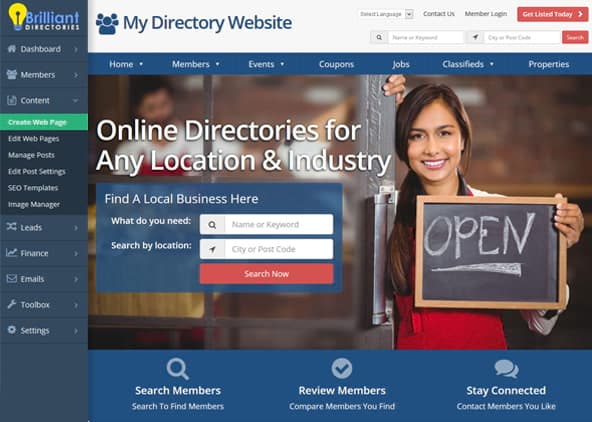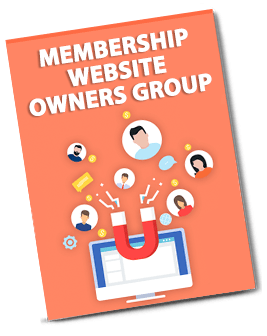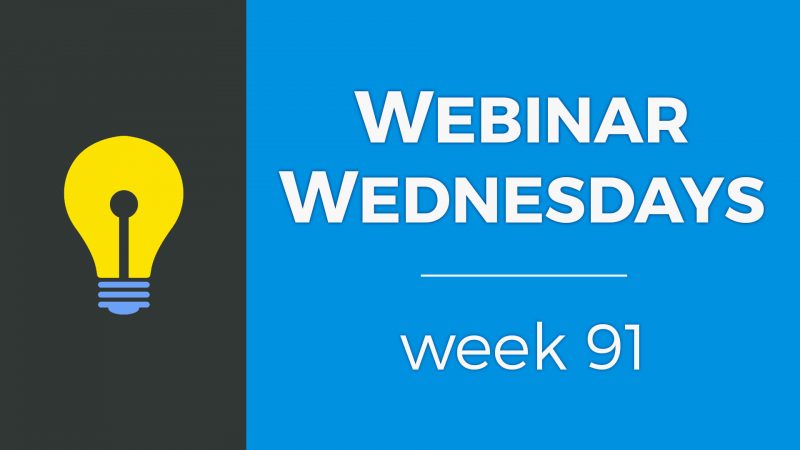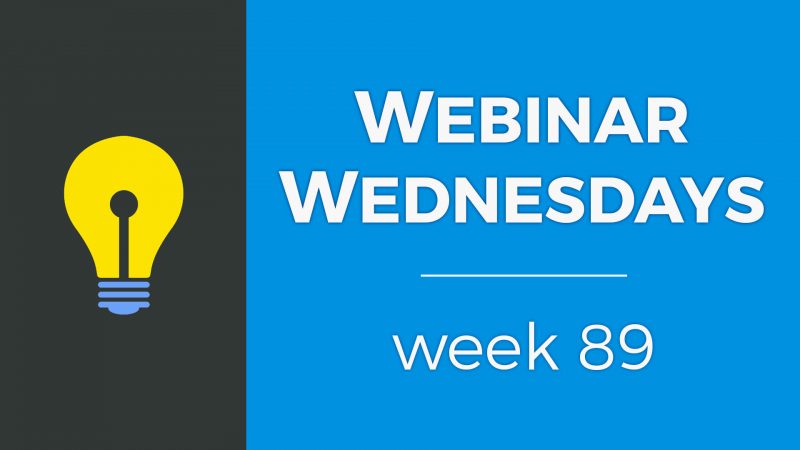
Key Topics:
- 3:41 – WEBHOOKS: When Members Add Profile Photos, Send The Data via Webhooks
- 5:06 – SIGN UP: Now You Can Easily COPY the Sign-Up Link of Membership Plans
- 6:14 – ADMIN: Screenshots Now Visible in “Form Manager” & “Edit Post Settings” Pages
- 7:36 – ADMIN: Keyword Search Filter When Creating Coupon Codes
- 8:46 – CHATS: Now Your Can See Both Members Involved in Private Chat Dialogue
- 9:43 – LEADS: See Total Revenue Generated for Each Lead
- 10:21 – NEWSLETTERS: Better, Smarter Workflow When Scheduling Newsletters and Stats After Sending
- 10:50 – SMART LISTS: Scheduled Times to Sync Smart Lists with Webhook Actions + Transaction History Smart Lists
- 12:28 – HOMEPAGE: 5 More Default “Custom Content” Slots for the Homepage – 10 Total Available
- 13:23 – TONS MORE: Speed, security, quality-of-life features and exciting new releases on the way!
- 14:17 – Include Additional CTAs In Your Homepage Hero Section
- 15:06 – What Is a Homepage Hero Section?
- 18:00 – Goal of Homepage CTAs
- 19:40 – Default Hero Section Functionality
- 20:18 – Add Custom Content & CTAs to Hero Section
- 22:28 – Customizing Hero Section without Custom Code
- 26:34 – Adding Custom Code to Homepage Hero Section
- Copy & Paste Code for Additional CTAs: Click HERE for Google Doc
- 30:18 – Additional Supportive Text
- 31:19 – Additional CTA Button
- 33:03 – Tag Cloud of Popular Searches
- 40:57 – Testimonial Blurb
- 45:50 – Sponsored Banner Ad or Promotion
- 49:07 – Can JavaScript be placed in widgets?
- 50:01 – Using Web Page Builder to Generate HTML to Place in Widgets
- 51:57 – Prompt users conducting a search to register?
- 58:10 – Search members by category sidebar widget
- 1:02:41 – Customize Members-Only Content paywall/login message?
- 1:07:11 – Sync Brilliant Directories with a CRM (Mailchimp)
- 1:08:39 – Thoughts on ChatGPT for content creation and how Google sees it? – ChatGPT Content Creator add-on
New Features
Coming Soon
Tip of the Week
Questions & Answers

 AI-Generated Transcript – Please excuse any inaccuracies
AI-Generated Transcript – Please excuse any inaccuracies
WEBHOOKS: When Members Add Profile Photos, Send The Data via Webhooks (00:03:41)
- Webhooks allow sending data from a website to other platforms, and there is a new webhook that sends image data when members add profile photos or logos to their profiles via webhooks (00:03:41).
- The new webhook can be used to send profile photos to other platforms, and it includes the member’s name, user ID, email address, and other key pieces of meta information (00:03:58).
- To find the new webhook in the admin area, users can go to the developer Hub, then to web hooks, and search for “photo” to quickly find the “profile photos form submitted” option (00:04:19).
- The webhook does not just send the image file extension of the profile photo or logo, but also includes other relevant information that can be mapped on third-party platforms (00:04:45).
- The data sent via the webhook can be used to map members on other platforms, allowing for integration with other systems and services (00:05:03).
SIGN UP: Now You Can Easily COPY the Sign-Up Link of Membership Plans (00:05:06)
- A new quality of life feature allows users to easily copy the sign-up link of membership plans, whether they are free or paid, which can be helpful when sharing the link in an email or using it on a landing page (00:05:07).
- The sign-up link can be copied by navigating to the finance and membership plans section, where a green button is available to view the sign-up page, and an option to copy the sign-up link is available under the actions drop-down (00:05:26).
- Additionally, other options are available under the actions drop-down, including a clone button to clone a membership plan, and the ability to move members between plans, which can be useful when deleting a plan and transferring members to an alternate plan (00:05:38).
- The clone button enables users to create a copy of a membership plan, make small changes to the new plan, and then use it as needed (00:05:46).
- The ability to move members between plans allows users to transfer members from one plan to another, such as moving free members to an alternate free plan, before deleting the older plan (00:05:55).
ADMIN: Screenshots Now Visible in “Form Manager” & “Edit Post Settings” Pages (00:06:14)
- Screenshots are now visible in the “Form Manager” and “Edit Post Settings” pages of the admin area to provide a helpful visual guide when working with elements, (00:06:15).
- The “Form Manager” page displays a small preview of what each form looks like, allowing users to gauge the appearance of forms that can be used on multiple pages of their site, (00:06:49).
- The “Edit Post Settings” page shows a preview of the search results page for certain post types, such as events, blog articles, and coupons, but not all post types have this feature, (00:07:02).
- The preview feature is available for the majority of post types, including discussions, and clicking on the preview takes users directly to the search results page for that post type, (00:07:23).
- The addition of screenshots in the “Form Manager” and “Edit Post Settings” pages is a quality of life update that was also recently added to the web page builder, (00:06:36).
ADMIN: Keyword Search Filter When Creating Coupon Codes (00:07:36)
- A new keyword search filter has been added to the easy coupon codes add-on, allowing for easier searching of digital products and paper posts when creating coupon codes, thanks to a suggestion from Ryan Sullivan (00:07:37).
- The new settings for the easy coupon codes add-on include the ability to create coupon codes for digital products and paper posts, in addition to signups and upgrades, and can be accessed under the Finance section by going to coupon codes and then new coupon code (00:08:02).
- The keyword search filter can be used to filter digital products and paper posts, and is specific to the tab being used, with a separate filter available for membership plans (00:08:22).
- The keyword search filter allows users to type in a keyword, such as “classifieds”, to quickly find specific items when creating a coupon code, making it easier to create targeted promotions (00:08:25).
- The new filter is designed to simplify the process of creating coupon codes for specific items, and is a useful tool for managing digital products, paper posts, and membership plans (00:08:34).
CHATS: Now Your Can See Both Members Involved in Private Chat Dialogue (00:08:46)
- The private member chat add-on in the admin area now provides a quality of life improvement, making it easier to manage chats between members (00:08:47).
- Previously, the admin area would only show the person who initiated the chat, but now it displays both members involved in the private chat dialogue (00:08:54).
- In the admin area, a preview of the chat is visible on the right-hand side, along with a module that provides information about the chat, including a badge indicating who started the chat and who they are chatting with (00:09:18).
- The module also includes a dropdown menu with actions such as logging in as the member, sending them an email, and other simple actions, and both parties involved in the chat are now listed (00:09:32).
- The update includes additional features and improvements, such as the ability to see both members involved in the chat and perform various actions, making it more convenient for administrators to manage member interactions (00:09:42).
LEADS: See Total Revenue Generated for Each Lead (00:09:43)
- A new feature will be available soon, allowing users to see the total revenue generated for each lead, providing a quick snapshot of which leads are selling through and which are not (00:09:45).
- The total revenue feature will be displayed on the member leads page, showing the total amount earned from each lead, such as $100 if one lead is sold for $25 to four members (00:10:02).
- The feature is expected to be released soon, with newsletters having been given priority, and will provide a useful tool for users selling leads to their members (00:10:18).
NEWSLETTERS: Better, Smarter Workflow When Scheduling Newsletters and Stats After Sending (00:10:21)
- A better UI and workflow for newsletters has been put on the back burner for a while, but it is expected to be released in July, which will be a comprehensive overhaul of the newsletter scheduling section (00:10:23).
- The upcoming release will not only improve the workflow but also provide good statistics on who opened and clicked the emails, allowing for a more informed approach to newsletter management (00:10:27).
- The new features will include the ability to create smart lists from segments of users who have interacted with the newsletters in specific ways, such as opening or clicking on emails (00:10:34).
- The overhaul of the newsletter scheduling section of the admin is expected to be a big release, indicating that it will have a significant impact on the way newsletters are managed and analyzed (00:10:30).
- The release will also provide users with the ability to track and analyze the performance of their newsletters, including statistics on who opened and clicked the emails, which will be available after the newsletters have been sent (00:10:40).
SMART LISTS: Scheduled Times to Sync Smart Lists with Webhook Actions + Transaction History Smart Lists (00:10:50)
- Smart lists can be created and synced with web hooks, allowing for dynamic updates and the ability to send contacts to third-party platforms, such as Mailchimp, with the option to sync daily, weekly, or monthly (00:10:53).
- The smart lists are dynamic, meaning members can move in and out of the list, and with a web hook, all those contacts can be sent to a third-party platform, making it possible to update emailing lists automatically (00:10:57).
- The smart list page will have options to sync now, as well as scheduled times to sync, such as daily, weekly, or monthly, allowing for real-time updates on other platforms (00:11:20).
- Smart lists on the transactions history page will soon be able to export results into a CSV file, allowing for filtered searches, and the ability to create a smart list from those results (00:11:52).
- The ability to create a smart list from transaction history results enables the creation of targeted groups, such as users who have paid using a coupon code, and send them newsletters (00:12:05).
- The main benefit of smart lists is being able to send newsletters to segmented groups of users, allowing for more targeted and effective communication (00:12:21).
HOMEPAGE: 5 More Default “Custom Content” Slots for the Homepage – 10 Total Available (00:12:28)
- The homepage has streaming sections that can be utilized to display custom content, with five spots currently available for this purpose (00:12:29).
- An additional five default custom content slots will be added to the homepage, bringing the total number of available custom content spots to 10 (00:12:34).
- The total of 10 available custom content spots on the homepage is expected to be sufficient for the vast majority of users, with the option to create a custom widget for those who require more than 10 spots (00:12:37).
- The custom content spots can be found on the homepage in the streaming sections, which will be able to include up to 10 custom content spots (00:13:07).
- Users who need more than 10 custom content spots are encouraged to create a custom widget to accommodate all their content, as 10 spots are expected to be adequate for most users (00:12:51).
TONS MORE: Speed, security, quality-of-life features and exciting new releases on the way! (00:13:23)
- The platform is receiving numerous updates, including speed and security enhancements, as well as quality-of-life features that improve the admin’s intuitiveness and ease of use (00:13:23).
- A significant majority of these updates are a result of suggestions from the community, who have been interacting with the support team, and their contributions are greatly appreciated (00:13:35).
- The community’s support and feedback have been instrumental in making the platform better for everyone, and their efforts have not gone unnoticed (00:13:42).
- Before proceeding to the tip of the week, there is an opportunity for users to ask questions or provide comments on the newly released or upcoming updates (00:13:57).
- The tip of the week will be presented next, and James has already provided feedback, stating that the updates are great and that everything is self-explanatory, allowing the presentation to move forward (00:14:09).
Include Additional CTAs In Your Homepage Hero Section (00:14:17)
- The topic of discussion is including additional calls to actions (CTAs) in the homepage hero section, which was an update teased about a month ago (00:14:18).
- This update allows for adding custom content of any kind in the hero section, such as a little piece of text, extra information, or additional calls to action (00:14:39).
- The hero section will be reviewed, along with some use cases, and custom code will be provided that can be copied and pasted into a site to add custom and additional calls to action (00:14:53).
- The goal is to enable the addition of custom and additional calls to action to the hero section immediately, a topic that has been covered before, specifically in relation to hero sections (00:15:04).
What Is a Homepage Hero Section? (00:15:06)
- The hero section is typically the most prominent section on a home page, used to grab a new visitor’s attention and communicate the main purpose, message, and value proposition of the website (00:15:08).
- A great hero section usually includes a large, full-width, high-quality image, sometimes with an embedded video, as well as a tagline, title, subtitle text, and a call to action, such as a forum submission or search form (00:15:54).
- The call to action in the hero section depends on the goal of the website, and it could be a simple search form, a button linking to other areas of the website, or a form to input an email address (00:16:16).
- The hero section should use a high-quality image and taglines or text that grab the visitor’s attention, letting them know what the website is for and encouraging them to click around and use the site immediately (00:16:49).
- It is generally recommended to keep the hero section simple, tidy, and clear without too much clutter, but there may be opportunities to add elements like testimonials to enhance the section (00:17:06).
- The hero section should aim to spark an emotional connection with the visitor by using high-quality images that portray the brand and the experience it will deliver, as well as images that reflect the visitor’s persona (00:17:31).
- The goal is to make visitors feel like they belong on the website and are encouraged to continue exploring the internal pages (00:17:52).
Goal of Homepage CTAs (00:18:00)
- The homepage hero section, along with its call to action, should help brand new visitors understand the website’s purpose through the image, title, and subtitle, and the calls to action should be relevant to push new visitors to conduct some sort of action on the website (00:18:01).
- The overall purpose of the hero section and its calls to action is to minimize bounce rate by getting visitors to quickly click and explore the website, and to present the brand as high quality and credible (00:18:23).
- A simple, high-quality image, potentially with a smiling face, can help present the brand as high quality, and small details, such as a ribbon or badge icon, can make new visitors feel that the website is credible (00:18:39).
- The use of features like “featured tutors” with a small icon can imply a vetting process, adding credibility to the brand, and it is essential to keep things simple and focused with a clear purpose in the hero section and its calls to action (00:19:00).
- The goal is to stay on point and avoid cluttering the hero section with too much information, ensuring that the calls to action are relevant and effective in guiding new visitors to take the desired actions on the website (00:19:25).
Default Hero Section Functionality (00:19:40)
- trgic The hero section on the home page has default design settings that allow for the addition of several elements, including a background image, main title text, subtitle text, and a primary search box or other call to action (00:19:41).
- The main title text and subtitle text can be used to provide additional information to go along with the title, and the primary search box or other call to action can be chosen based on specific needs (00:19:46).
- Alternatively, instead of a search box, other call to actions can be used, such as a couple of buttons linking to other pages on the website, providing flexibility in the design of the hero section (00:20:03).
- The design settings for the home page hero section provide a range of options for customizing the appearance and functionality of this key section of the website (00:20:14).
Add Custom Content & CTAs to Hero Section (00:20:18)
- A new update has added two new widgets that can be edited, one above and one below the search box or call to action, allowing users to drop any custom code to expand the usefulness of the hero section (00:20:19).
- Some popular use cases for the hero section include adding additional supportive text to go along with the main title and subtitle text, as well as adding a Tag cloud of popular searches to give users suggestions (00:20:47).
- Users can also add additional calls to action, such as a button that links visitors to a registration page or join page, and can add custom images or a banner ad into the hero section through this method (00:21:11).
- Another use case is adding a testimonial to the hero section, which can be a great way to showcase user feedback and can be implemented using a simple code (00:21:32).
- The examples that will be shown require a little bit of simple coding, and users can choose to add one or more of the popular use cases to their hero section, depending on how they want to display them on their site (00:21:44).
- It is suggested that users do not use all of the available use cases, as it could clutter the page, but they can use one or two, or more, depending on how they are displayed on the site (00:22:07).
Customizing Hero Section without Custom Code (00:22:28)
- The design settings for the home page can be customized without using custom code, allowing for changes to be made by pointing and clicking on the site (00:22:29).
- The hero section of the home page can be customized with a search box or call to action, and custom content can be added using a text editor, which allows for the addition of images, videos, and pre-made elements (00:22:50).
- The custom content option can be replaced with a keyword search or keyword and location search, and up to three button links can be displayed using the display button links feature (00:23:08).
- The goal of the hero section is to reduce the bounce rate and guide visitors to internal pages of the website, and it is important to consider the journey being created for the visitor and the pathways being presented to them (00:24:42).
- The hero section can also be customized with a keyword and location search, and the layout can be adjusted to left align or center the content, with options to add custom content CTAs and edit widgets (00:25:25).
- The title text in the hero section can be adjusted to control how far it moves into the page, allowing for a tidy and organized layout (00:26:21).
Adding Custom Code to Homepage Hero Section (00:26:34)
- To edit the widgets, click on the orange “visit website” button to access the admin bar and then click on “show widgets” to view all the modular components that make up the page (00:26:36).
- The two new widgets are “bootstrap stream Home Page search extra content above” and “bootstraps theme Home Page search extra content below”, which can be customized by clicking on them and then editing the widgets (00:26:59).
- A Google doc has been created to provide examples and guidance on editing the widgets, and some custom modules have been created for the home page, including two customized widgets that have been disabled (00:27:07).
- The customized widgets include a main title and five components: a snippet of paragraph text, a button, popular searches, a testimonial or blurb, and a banner ad spot (00:27:52).
- The popular searches component allows users to link to specific categories or searches on their site, which can be particularly useful for regionally specific or niche websites (00:28:14).
- The testimonial or blurb component can be used to show social proof and build trust with visitors by showcasing reviews or ratings from other websites (00:28:56).
- The banner ad spot can be used to sell ad space to members or promote the website’s own content, and can include embedded Google ad code or custom images (00:29:13).
- The “extra content above” section includes two customized sections: a snippet of text and a blue button that links to a call to action, such as listing a company (00:29:56).
Additional Supportive Text (00:30:18)
- The additional supportive text is a paragraph of text that can be added below the title, and it is available in the widgets to edit in the dock (00:30:18).
- This text can be copied and pasted into the bootstrap theme Home Page search extra content above widget, allowing users to have a paragraph of text that can be replaced with their own content (00:30:31).
- The text in the Google Doc can be replaced with any desired text, and users familiar with HTML and CSS can edit the text further if needed (00:30:50).
- Users who are not familiar with HTML and CSS can still use the text as is and simply edit the black text, then copy and paste it into the widget (00:31:01).
- For users with some knowledge of HTML coding, there is the option to enhance the text further and make customizations (00:31:12).
Additional CTA Button (00:31:19)
- The button can be used as a member sign up or a lister company, and it is suggested to use it for members-only websites where users need to create an account for access to premium content (00:31:19).
- The button link URL can be replaced by modifying the href, which currently links to the forward slash join page of the website, and can be changed to link directly to a checkout page for quick registrations (00:31:41).
- The link to the sign up page can be copied from the finance section and utilized in the href, and the text of the button can be replaced with a custom message (00:32:10).
- The button can be placed directly above the search bar, and having a simple paragraph of text and a button can encourage user registration and sign up in an elegant and non-busy way (00:32:35).
- The button’s link text can be customized by replacing the existing text with a desired message, allowing for a personalized call-to-action (00:32:28).
Tag Cloud of Popular Searches (00:33:03)
- The popular searches feature is a useful tool that can be customized with different titles, such as “top searches” or “quick search”, and can be translated into various languages, with the ability to add line breaks for better readability (00:33:32).
- The feature includes a Tag cloud of popular searches, which can be limited to a certain number of links, and each link can be customized with a specific href link to a search results page (00:34:02).
- To find a search results page for a category, users can perform a keyword search or use the browse categories feature in the footer, and then click on “view all” to obtain the link for that category (00:34:29).
- The link for a category can be edited in the HTML code, with the visible text and the href link separated by the “=” sign, and users can replace existing links with new ones, such as replacing “lawyers” with “restaurants” (00:35:03).
- Alternatively, users can find the link for a category in the member categories section, where they can copy the URL for a specific category, such as “restaurants”, and use it to create a new link (00:35:41).
- The HTML code for the popular searches feature can be customized and shortened to fit the needs of the user, with the ability to add or remove links and edit the visible text (00:36:33).
- The hero section of a home page is designed to encourage users to take action, such as conducting a search or reading the page content, and quick SLATES can help achieve this by adding a sense of intrigue and convenience to the page (00:36:42).
- The quick search links can be presented in a way that makes it easy for users to find what they are looking for, and using bootstrap columns can help to organize the content and make it more visually appealing (00:37:38).
- The size of the quick search links can be adjusted by changing the column size, for example, from 6 to 10 or 12, to provide more space for the links (00:37:41).
- Quick search links can be useful for national or statewide directories, where users can be linked to search results for specific areas, such as top metro areas (00:38:00).
- To create a quick search link, a search can be conducted for a specific area, such as Los Angeles, and the resulting URL can be used as the href code for the link (00:38:24).
- The URL for the quick search link can be simplified by using the canonical URL, which is the user-facing URL, rather than the full URL with dynamic searches (00:38:59).
- The quick SLATES can be used to direct users to specific search results pages or other pages on the site that are relevant to their interests, such as events or coupons (00:39:58).
- The main search function on the site can be used for searching members or business listings, while the quick search can be used for other parts of the site, such as events or coupons (00:40:11).
- Examples of homepage HERO SECTION CTAs can be in line with a local business directory, particularly if serving a specific region like Los Angeles, and having a link to events would make sense in this context (00:40:30).
- The link to events can be relevant because the business is already operating in a specific location, such as Los Angeles, and the events are also taking place in the same location (00:40:32).
- The link can be to a post type’s URL, and the categories for the link can be more than one, including specific locations, post types, or a combination of all those options (00:40:36).
- The possibilities for the link categories are flexible and can include various combinations, such as multiple categories, specific locations, post types, or a mix of these options (00:40:46).
- The discussion moves on to the next section after considering the options for linking to events or other relevant pages from the homepage HERO SECTION CTAs (00:40:56).
Testimonial Blurb (00:40:57)
- A testimonial blurb can be added to a website’s homepage to establish credibility and trust with visitors, and it can include an image and text, such as a quote from a member or advertiser, with a star rating, (00:40:59).
- The testimonial blurb has two main components: the testimonial image and the testimonial text, which can be customized to include the name of the person providing the testimonial, and can be styled using HTML tags, (00:41:57).
- To add an image to the testimonial blurb, an image can be uploaded to the media manager, and the URL of the image can be copied and pasted into the testimonial blurb code, (00:42:14).
- The image URL can be obtained by right-clicking on the image in the media manager and selecting “copy URL”, and the URL can be shortened to just the part after the first forward slash if the image is being used on the same website, (00:42:32).
- The testimonial text can be customized to include the name of the person providing the testimonial, and can be styled using HTML tags, such as the small tag to make the text smaller, (00:43:34).
- The placement of the testimonial blurb on the homepage can be adjusted to be above or below the sign-up button, depending on the desired layout and design, and can be used to motivate visitors to join the site, (00:43:55).
- The testimonial blurb can also be used to feature specific members or sell ad space on the homepage, by using a photo of a member as the main hero image and adding additional information as text, (00:44:45).
- This approach can be used to create a “takeover” of the homepage, with a background image that matches the testimonial text or sponsorship text, and can be a great way to sell ad space on the site, (00:45:08).
- Offering the first featured spot on the homepage for free can create excitement among members and encourage them to want to be represented on the homepage, (00:45:39).
Sponsored Banner Ad or Promotion (00:45:50)
- A sponsored banner ad or promotion can be added to a homepage, which can be an image created to showcase a service being offered, and it can be an internal banner ad that promotes one of the organization’s own services or an affiliate link to something else, with the choice being the customer’s (00:45:50).
- The banner ad can be linked to a specific page, such as a join page, and can include an image that is uploaded to a media manager, with the image source and banner URL being referenced in the code (00:46:14).
- The addition of a banner ad to the homepage can be done by adding a snippet of code to an empty widget, making it easier for web designers to customize the content without having to edit complicated home page code (00:47:01).
- More advanced customization options are available for higher-level web designers, such as creating tabbed content on the homepage, with the ability to change the content based on what is being clicked, and adding quick links under the search module (00:47:22).
- The use of custom widgets and code snippets can allow designers to add a wide range of content to the homepage, from simple text and links to more complex layouts and designs, with the potential to “go crazy” and create unique and customized content (00:48:25).
- The examples provided can be used as a starting point for adding custom content to the homepage, with the option to copy and edit the code to suit specific needs, and the ability to use point-and-click settings or more advanced HTML and CSS coding (00:48:31).
Can JavaScript be placed in widgets? (00:49:07)
- It is possible to place a small snippet of JavaScript in the new sections that can be created, allowing for external requests to other services, such as displaying rotating banners (00:49:07).
- To avoid slowing down the load time of the home page, it is recommended to add a delay or timeout when making external requests (00:49:32).
- Embedding JavaScript code is allowed pretty much anywhere a widget can be rendered, giving users the flexibility to add custom functionality (00:49:54).
- The ability to embed JavaScript code can be useful for creating dynamic content, such as rotating banners, and can be done without restricting the user’s ability to customize their home page (00:49:58).
- The question about embedding JavaScript code was asked by Jim, and it was confirmed that there are no restrictions on adding custom JavaScript code to the new sections (00:49:52).
Using Web Page Builder to Generate HTML to Place in Widgets (00:50:01)
- For individuals unfamiliar with HTML, CSS, and JavaScript who want to add custom content to home page hero section widgets, they can use the web page builder to create and customize their content, then copy and paste the generated HTML code into the widgets (00:50:07).
- The web page builder’s visual editor allows users to create and manipulate content visually, which can then be copied in code view and pasted into a custom widget, providing an alternative to directly writing or editing HTML code (00:50:42).
- By using the web page builder, users can create custom content, such as a content block, and then switch to code view to copy the generated HTML code, which can be pasted into a widget, allowing for more flexibility and customization options (00:50:51).
- This approach enables users to work around any limitations of the provided examples or Google Doc resources, and instead, use the web page builder to generate the desired HTML code for their widgets (00:51:21).
- After pasting the generated HTML code into a widget, users can save their changes and see the customized content rendered in the widget, as demonstrated in the example where four content blocks were added to a widget (00:51:12).
- The discussion then shifts to addressing questions from participants, including Nadia, who is calling from New York City and has questions about using the platform, indicating that the conversation is moving on to a new topic (00:51:30).
Prompt users conducting a search to register? (00:51:57)
- A search function on the homepage can be configured to direct non-paid members to a sign-on page, allowing for better lead utilization, and this can be achieved with the members-only add-on by protecting search results pages (00:51:57).
- When a brand new person visits the homepage and uses the search form, they can be prompted to create an account if they don’t have one already, and this can be done by enabling the express member registration in the general settings (00:52:31).
- The express member registration allows people to register on the same page without being redirected to another sign-up page, making it easier for them to continue accessing members-only content (00:54:27).
- The members-only add-on provides options to protect search results pages and display a message prompting users to log in or become a member, and this message can be customized to fit the website’s needs (00:53:35).
- Enabling the express member registration and configuring the general settings can help improve the user experience and increase membership engagement by streamlining the registration process (00:55:00).
- The express member registration feature can be used in conjunction with other settings, such as the general user account and start with express registration tab, to create a seamless registration process for new users (00:55:03).
- Advanced settings can be used to proceed to the same page and find specific settings, such as Express, which can be enabled to control member registration and access to certain pages (00:55:56).
- When someone encounters a paywall or member’s only wall, they can be encouraged to register by showing them search results pages with limited information, while protecting the detail pages with members’ information (00:56:22).
- The search results pages do not need to be protected, but the detail pages with members’ information can be protected by editing the membership plans and choosing which ones are protected (00:56:50).
- The membership plans can be edited to choose which profiles are protected, and visitors may see limited information in search results, but will be prompted to register or log in to access more information (00:57:14).
- The message displayed to visitors when they try to access protected content can be modified, and the default message is “this content is for members only” (00:57:51).
- The settings and protections can be tested by logging out and searching for members, which will display limited results and prompt the visitor to register or log in to access more information (00:57:37).
Search members by category sidebar widget (00:58:10)
- The search members by category sidebar widget is being discussed, with a user having a large number of categories that results in a never-ending scroll on the page, and they are looking for a way to make it more manageable, such as using an accordion file (00:58:12).
- The user’s website, bluehoop.com, is being reviewed, and the filter by category section is being examined to find a solution to the issue of having too many categories (00:58:38).
- A possible solution is to set a maximum height for the category filter, such as 300 or 400 pixels, to prevent endless scrolling (00:59:06).
- The user is being advised to consider using a regular search filter where people can search one category at a time, rather than using a dynamic category filter with many categories (00:59:31).
- The search module in the members search results sidebar is being edited to apply the changes, and the user is being shown how to access the edit post settings and additional settings to make the necessary changes (01:00:06).
- The dynamic category filter is being removed, and a location search is being added, as the user wants to include location search within a county (01:01:06).
- The changes are being saved, and the page is being refreshed to show the updated search results with a more organized category filter (01:01:24).
- The new search results page is being reviewed, and it is noted that the dynamic category filter may not be suitable for a large number of categories, and that the new filter is more user-friendly (01:02:02).
- The user is being assured that the changes made to the search results page do not affect the appearance of the home page (01:02:16).
Customize Members-Only Content paywall/login message? (01:02:41)
- To customize the members-only content paywall/login message, the process involves protecting a section of the site, such as the member search results page, and then viewing the protected page to see the generic message that pops up, which can be customized by changing the text labels (01:02:43).
- The text labels that make up the sentence can be edited, and new text can be added, such as a longer singular message, or even other elements like a video or a form (01:04:20).
- The customization options include deleting parts of the text labels, adding new text, and even embedding videos from platforms like YouTube or Vimeo, which can be done by copying the embed code and pasting it into the text label (01:05:31).
- The text labels can support not only text but also widgets or forms, allowing for more complex and interactive content to be added to the paywall/login message (01:05:52).
- The customization process allows for a high degree of flexibility and creativity, enabling users to create a unique and effective paywall/login message that suits their needs (01:06:20).
Sync Brilliant Directories with a CRM (Mailchimp) (01:07:11)
- A client wants to sync their Brilliant Directories form fill data with their CRM, such as Mailchimp, using a web hook, allowing the data to be sent automatically to the desired platform (01:07:13).
- The same concept of using a web hook to send data to any platform can be applied to any form and platform, with tools like Zapier serving as a conduit to capture the web hook and send it to the desired platform (01:07:35).
- Zapier is used to capture the web hook and send the data to any platform, including MailChimp, and other solutions like Pably can also be used to achieve this (01:07:48).
- Some solutions can accept web hooks on their own, but tools like Zapier make it incredibly simple to sync data between platforms, such as syncing Brilliant Directories data with MailChimp (01:08:01).
- To sync Brilliant Directories data with MailChimp, a web hook can be added, and additional help can be found in a previously shared demo or by asking in the Facebook group or support team (01:08:11).
- Zapier’s API can also be used to sync data between platforms, and it is mentioned as a useful tool for achieving this, with a demo available to illustrate the process (01:08:34).
Thoughts on ChatGPT for content creation and how Google sees it? (01:08:39)
- ChatGPT is used as a tool to generate content, but it’s essential to add personal touches and not rely solely on the generated text, and this approach helps to avoid potential issues with Google considering it as spam (01:08:39).
- The API provided by ChatGPT can be a useful starting point for content creation, allowing users to fill in gaps or figure out ideas, and it’s crucial to use it as a guide rather than copying the content exactly as it is (01:09:14).
- When using the ChatGPT API, the generated text is in plain format, with no embedded code, except for line breaks, making it easy to edit and modify after it’s been printed (01:09:53).
- The use of ChatGPT for content creation is seen as a helpful tool, and it’s essential to follow best practices, such as adding personal content and not relying solely on the generated text, to avoid any potential issues with search engines like Google (01:09:04).
- The discussion highlights the importance of using Kitt GPT responsibly and creatively, allowing users to produce high-quality content while avoiding potential pitfalls, such as being flagged as spam by Google (01:09:08).














